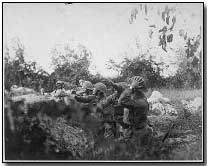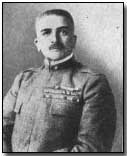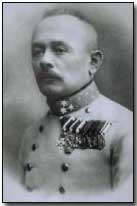Battles - The Battle of Vittorio Veneto, 1918
 The Battle of Vittorio
Veneto, which saw the Italians destroy the vestiges of the Austro-Hungarian
army, heralded the wartime defeat of Austria-Hungary and an end to its
Empire. It was the final action fought on the Italian Front.
The Battle of Vittorio
Veneto, which saw the Italians destroy the vestiges of the Austro-Hungarian
army, heralded the wartime defeat of Austria-Hungary and an end to its
Empire. It was the final action fought on the Italian Front.
Despite the resounding defeat of the Austro-Hungarians at the Battle of the Piave River in June 1918 the cautious Italian Chief of Staff Armando Diaz hesitated to press home his advantage over the Austro-Hungarians, preferring to confine the army to local operations. This was despite appeals from both Ferdinand Foch - the Allied Supreme Commander - and Lord Cavan, commander of British forces in Italy.
However the advancing successes of Italy's allies on the Western Front - which effectively ruled out German assistance to their Austro-Hungarian allies on the Italian Front (with the Germans themselves requesting assistance in France) - brought about a change of heart. The Italian government, keen to ensure the maximum territorial gains ahead of the ensuing peace conference, added to the chorus of pressure upon Diaz.
 Thus he resolved to launch
a combined offensive. A primary assault would be launched on the
Piave, intended to advance upon Vittorio Veneto.
Thus he resolved to launch
a combined offensive. A primary assault would be launched on the
Piave, intended to advance upon Vittorio Veneto.
Diaz reasoned that this would cause a separation of Austro-Hungarian forces on the Adriatic plains from those in the mountains - at which point he would simply 'roll up' the isolated Austro-Hungarian mountain force.
Separately to the west, at Mount Grappa, the Italian Fourth Army would penetrate the Austro-Hungarian lines held by Archduke Josef (in the west) and Boroevic von Bojna (in the east running along the Piave). Facing the Austro-Hungarians across the river were four Italian armies - the Third, Eighth, Tenth and Twelfth.
The combined Italian force totalled a sizeable 57 divisions, of which three were British and two French, along with a single U.S. regiment. Ranged against them were 52 nominal Austro-Hungarian divisions. In terms of artillery the Italians also held the advantage with 7,700 guns to 6,030. Crucially, Italian morale was notably higher than the thoroughly demoralised Austro-Hungarian force.
The attack opened on 23 October 1918 with an Italian advance in the mountains. However the extent of Austro-Hungarian resistance surprised Diaz and succeeded in preventing any significant Italian gains, although the Austro-Hungarians were obliged to bring up reserves from the Lower Piave. Such reserves could be ill-afforded given that the main Italian advance began the same day in the Lower Piave.
 Lord Cavan's Tenth Army
succeeded in capturing Papadopoli Island two days later, on 25 October.
On 27 October his force was again to the fore, succeeding - in spite of a
river flood - in establishing a bridgehead across the river, meeting with
relatively light Austro-Hungarian resistance.
Lord Cavan's Tenth Army
succeeded in capturing Papadopoli Island two days later, on 25 October.
On 27 October his force was again to the fore, succeeding - in spite of a
river flood - in establishing a bridgehead across the river, meeting with
relatively light Austro-Hungarian resistance.
Some 24km further north Twelfth Army, led by General Graziani, also crossed the river and likewise established a bridgehead; Eighth Army followed to Graziani's right. Shortly afterwards Cavan despatched two detachments to clear the river of remaining Austro-Hungarian resistance after which the bridgeheads were joined.
With Cavan's main force pushing ahead on 27 October the Austro-Hungarian Fifth Army was forced back. Three days later the Italian Third and Tenth Armies succeeded in reaching the River Livenza and Eighth Army took the primary target of Vittorio Veneto, thereby splitting the Austro-Hungarian armies.
With the Allies' succeeding in advancing 24km along a 56km front a truce was finally agreed on 2 November with the capture of Tagliamento; an armistice came into effect the following day, signed at Padua. Hostilities were formally concluded on 4 November 1918.
A resounding success for the Allies, the Battle of Vittorio Veneto finished the Austro-Hungarian army as a fighting force. The Italians lost some 38,000 casualties, a figure dwarfed by the 300,000 prisoners suffered by the Austro-Hungarians. Simultaneous political turmoil completed the disintegration of the Austro-Hungarian Empire.
Click here to view a map charting the course of the battle.
Photographs courtesy of Photos of the Great War website
"Harry Tate" was the nickname given by British pilots to the R.E.8 aircraft
- Did you know?
